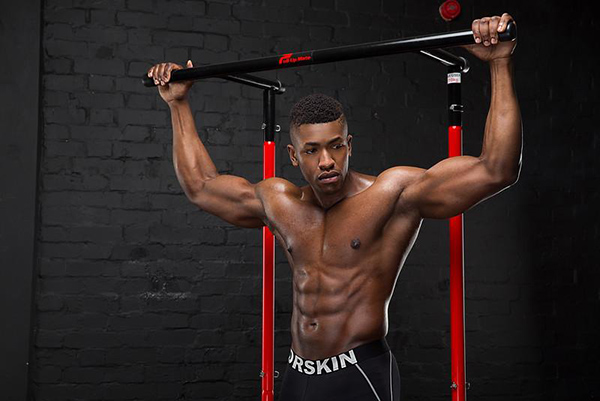
Can pull-ups truly play a significant role in enhancing one’s height? This is a question that has sparked the curiosity of many individuals, especially those who understand the profound impact of human growth hormone (HGH) on our vertical growth. High-intensity workouts have been demonstrated to stimulate the release of HGH, a hormone with the potential to improve posture and foster a taller stature. Among these high-intensity exercises, pull-ups often come under scrutiny regarding their potential influence on height. To uncover the answers, let’s delve deeper into this fascinating subject.
Why do pull-ups contribute to height enhancement?
Contrary to popular belief, pull-ups do not directly lead to an increase in height. However, they can exert an indirect effect by enhancing your posture through the strengthening of your upper body and core muscles. This improved posture enables you to stand more erect, creating the illusion of increased height.
As mentioned earlier, pull-ups trigger the release of both human growth hormone (HGH) and testosterone. HGH plays a crucial role in maintaining muscle tissues and promoting muscle growth, while testosterone aids in protein synthesis for muscle development. Even if you’ve reached your maximum height, engaging in pull-ups can still be advantageous for preserving bone density and regulating metabolism.
Furthermore, pull-ups can contribute to a more elongated appearance for your body. By pulling yourself up, you elongate your chest and broaden your shoulders, resulting in a V-shaped silhouette. Choosing well-fitted clothing can further enhance the perception of height.
Additionally, pull-ups strengthen the deep core and back muscles, which play a role in proper alignment and balance in your upper body. With a well-supported and aligned spine, you are less likely to slouch or experience discomfort, ultimately creating the impression of increased height.

How to Perform Pull-Ups Correctly for Height Growth and Maximum Benefits
If you want to harness the potential benefits of pull-ups and possibly aid in promoting height growth, it is crucial to execute the exercise with precision. Follow these guidelines for proper form and technique:
- Establish a comfortable grip on the bar, either with both hands facing away from you or toward you. Avoid straining your thumbs while holding the bar.
- Stand upright with a slight chest protrusion, maintaining good posture.
- Ensure that the bar is positioned at a height that allows you to reach it by jumping while keeping your feet from touching the ground.
- Initiate the movement by bending your elbows and pulling yourself upwards until your chin surpasses the bar.
- To maintain equilibrium and stability, consider crossing your legs and maintaining a centered, vertical body position. It is essential to resist any swinging motion.
- Pause briefly at the pinnacle of the movement before gradually lowering yourself down under control.
- Repeat the next pull-up before your arms reach full extension.
By adhering to these steps and executing pull-ups correctly, you can optimize the potential benefits of this exercise. However, it’s crucial to understand that pull-ups alone cannot directly lead to height increase. Instead, they can contribute to better posture and muscle development, which may create the appearance of greater height.
How Many Pull-Ups to Facilitate Height Growth in One Week?
Hanging from a bar with both hands can provide a stretching effect on your muscles. However, it’s important to realize that achieving significant height growth within just one week is unattainable. The process of becoming taller is a gradual one, and patience is a fundamental requirement.
There isn’t a specific number of pull-ups that guarantees height increase. The primary focus should be on gradually strengthening the muscles that support your spine. While there may be various guidelines available, it’s important not to become overwhelmed. For those who are beginners or find it challenging to perform a single pull-up, consider using a pull-up station with assistance or supporting weights at a gym. This can help reduce the effort required to lift yourself up and down.
Fitness experts recommend commencing with five pull-ups during the first week and progressively increasing the number each week. Initially, incorporating pull-ups into your routine twice a week is a sensible starting point. Additionally, integrating other upper-body exercises such as weightlifting can enhance grip strength and contribute to overall muscle development.
Keep in mind that consistency and gradual progression are vital elements for achieving positive results. Commit to your exercise regimen with patience for long-term benefits

What are some additional advantages of incorporating pull-ups into your fitness routine?
Enhance Grip Strength
By consistently performing pull-ups and developing a strong grip, individuals can significantly improve their performance in activities that demand a firm hold, such as rock climbing or martial arts. Furthermore, a robust grip has been linked to better cardiovascular health, as individuals with greater handgrip strength typically exhibit improved heart function and structure.
Increase Workout Intensity
Whether you’re a beginner, out of shape, or new to pull-ups, even a few repetitions can be challenging and induce perspiration. However, as you progress, you can gradually increase the number of sets and repetitions. If you seek to intensify your workout, you can safely use straps or attach dumbbells to your ankles to add resistance.
Enhance Cardiovascular Health and Promote Fat Loss
Pull-ups offer a two-fold benefit to your fitness regimen. Firstly, as a compound exercise, they engage both major and minor muscle groups, requiring more calories and oxygen for efficient functioning. Consequently, this leads to an increased heart rate and improved cardiovascular health. Secondly, performing pull-ups allows you to maximize energy expenditure and burn more calories. Setting a goal to complete as many pull-ups as possible within a 30-second timeframe can provide an additional boost to fat burning. Notably, individuals with a leaner physique often find pull-ups easier to perform.
Boost Overall Health
Regularly incorporating pull-ups into your fitness routine can have a wide range of positive effects on your health. These include reducing blood pressure, decreasing visceral fat and waist circumference, improving blood sugar control and insulin sensitivity, lowering cholesterol and blood lipid levels, and enhancing overall body composition. By incorporating pull-ups and other total-body conditioning exercises, the risk of developing conditions such as type 2 diabetes, obesity, metabolic syndrome, and cardiovascular disease may be significantly reduced.
Enhance Mood
Similar to cardio workouts and aerobic exercises, engaging in pull-ups can help reduce cortisol levels and trigger the release of endorphins, often referred to as “happy chemicals.” Endorphins contribute to feelings of happiness and euphoria while also helping to prevent mood swings, anxiety, and depression. Additionally, exercise promotes the release of endocannabinoids, further enhancing relaxation, mood improvement, and reduced perception of pain

Do not require much equipment
If some strength training exercises require heavy or bulky weights and cannot be performed on the go. You only need a good pull-up bar or simply make the most of tree limbs or free bars in parks or playgrounds.
In conclusion,
Consistently incorporating pull-up exercises into your fitness routine yields a myriad of beneficial effects on the body. Firstly, this regimen promotes bone health by facilitating bone stretching and encouraging the formation of new cartilage layers. Furthermore, the dynamic motion of pulling oneself up and down during a pull-up workout redistributes the gravitational load on the body, thereby alleviating the stress on bones and joints. Additionally, pull-ups are highly effective in targeting and fortifying the muscles in the upper body, thereby contributing significantly to overall fitness enhancement.
Over time, a regular pull-up routine can lead to substantial gains in physical strength and even create the illusion of increased height. An intriguing feature of pull-ups is their versatility, as they can be performed virtually anywhere, making them a convenient addition to any fitness regimen. Commencing pull-up training early in your fitness journey allows for the early observation of these transformative results.
- Related post: Does Swimming Make You Taller?






